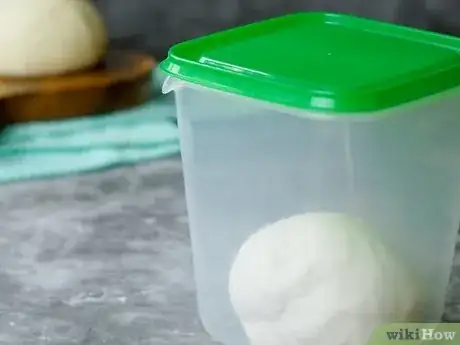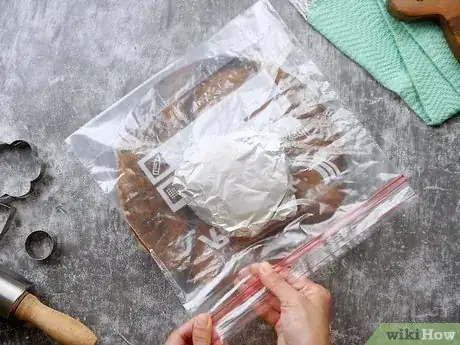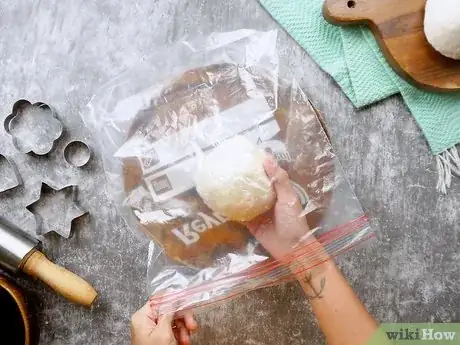This article was co-authored by wikiHow Staff. Our trained team of editors and researchers validate articles for accuracy and comprehensiveness. wikiHow's Content Management Team carefully monitors the work from our editorial staff to ensure that each article is backed by trusted research and meets our high quality standards.
There are 7 references cited in this article, which can be found at the bottom of the page.
The wikiHow Culinary Team also followed the article's instructions and verified that they work.
This article has been viewed 42,598 times.
Learn more...
Making dough ahead of time is a great way to have fresh baked goods without as much work. You can refrigerate for a short time or freeze it for about 1 month, while you can keep pizza dough frozen for slightly longer (about 3 months), as it doesn't rely as heavily on the yeast when you take it out to bake. You can also store cookie dough in the refrigerator for 2 days or in the freezer for about 6 months for fresh-baked cookies at a moment's notice.
Steps
Storing Bread Dough
-
1Put the bread dough in an airtight container in the fridge for up to a day. Choose a container that's twice the size of the dough. Dough can double in size in a single day in the fridge, which can make it spill out of smaller containers.[1]
- Store the dough in the refrigerator after the first rise. Let it rise again on the counter when you pull it out of the refrigerator.
- If the recipe only calls for one rise, place the dough in the fridge after you knead it. The dough will slowly rise in the fridge, so punch it down a few times in the first couple of hours.
-
2Store dough in the freezer if you want to keep it for more than a day. Because bread dough only lasts about 24 hours in the fridge, stick it in the freezer if you want to store it longer. Transfer it to the freezer after you've had it in the fridge, or store it in the freezer immediately after making it if you know you don't want to use it the next day.[2]Advertisement
-
3Form discs after the dough is kneaded for the freezer. To freeze dough, start with freshly kneaded dough before you let it rise. Flatten it into discs that are about 1 in (2.5 cm) thick. Each disc should contain the amount you want for one loaf or roll.
-
4Freeze the discs on a baking tray. Lay the discs out on a baking tray so they're not touching. Put the dough in the freezer for an hour or so, until the discs are frozen solid.
-
5Wrap the discs for storage. Cover each disc completely with aluminum foil or plastic wrap. Place the discs in a freezer bag, and squeeze all the air out of the bag. Put the dough in the freezer for up to a month.
- To thaw, set a disc on your counter. Let it thaw out, and then place it in a covered bowl to let it rise. Punch the dough down, and shape it how you'd like. Let it rise again before baking it.
Keeping Pizza Dough Fresh
-
1Cover pizza dough tightly in the fridge for up to 2 weeks. Once your pizza dough has risen for the last time, use plastic wrap to cover the surface completely. Place it in the fridge for up to 2 weeks.[3]
- The plastic wrap helps keep the dough from forming a skin on the surface.
-
2Freeze the dough immediately or after 2 weeks. If you don't plan on using all of your dough, you can freeze some of it immediately. Alternatively, if you've had it in the fridge for a week or 2 and want to keep it fresh, you can put it in the freezer instead.[4]
-
3Separate the dough into individual balls before freezing. Once the dough has risen for the last time or has been in the refrigerator, roll the dough into balls. The balls should be the size you normally use for baking a pizza. If you're not sure, try weighing out 0.5 lb (0.23 kg) of dough.[5]
- Pinch the dough off and gently shape it into a ball. You may need to lightly flour your hands if the dough is sticky.
-
4Cover each ball lightly with olive oil before freezing them. You can also use cooking spray or even just vegetable oil. The oil will help keep the dough from sticking to the bag.[6]
- The dough needs a very thin coating of oil.
-
5Place each dough ball into an individual freezer bag. Once it's in the bag, squeeze out as much air as you possibly can. Seal up the bag, and place the ball into the freezer for up to 3 months.[7]
- To thaw, set it on the counter for about 30 minutes.
Putting Cookie Dough in Storage
-
1Cover cookie dough and place it in the fridge for up to 2 days. Use plastic wrap or aluminum foil to cover the dough, which will keep it from drying out too much. Make sure the cover is over the whole surface of the dough.[8]
- Some doughs, such as sugar cookie doughs, need to be chilled for a set time to make forming the cookies easier, though you can still store the dough even if it doesn't have that requirement.
-
2Place the dough in the freezer immediately or after 2 days in the fridge. If you want, you can put the dough in the freezer immediately after making it. However, you can also freeze dough as way of saving it if it's been in your fridge too long.[9]
- If the dough has a chill stage, you don't need to complete that step before placing it in the freezer.
- Cookie dough lasts about half a year in the freezer.
-
3Scoop out individual cookies before freezing scoop-and-bake cookies. This category includes cookies like oatmeal raisin and chocolate chip. Portion out the dough as you normally would on a baking tray. Freeze the cookies on the tray, and then gather them up in a zip-top bag.[10]
- You don't even need to thaw this dough; just bake the cookies from frozen with a couple of extra minutes added to the baking time.
-
4Form discs out of the dough if you're freezing cut-out cookie dough. Doughs like sugar-cookie dough and gingerbread cookies cannot be frozen in their shapes. A disc-shape is best, because it thaws quickly and it is easy to roll out.[11]
- Place the disc into a zip-top bag, and squeeze out any air before freezing.
- Let these doughs thaw in the refrigerator or on the counter until they soften enough to roll out. They'll soften overnight in the fridge and within 1-2 hours on the counter, depending on how thick they are.
-
5Roll the dough into logs if you're freezing cut-and-bake cookies. Cookies that fall into this category include shortbreads and other dense, crumbly cookies like sandies. The log shape makes them easy to slice after just a bit of thawing.[12]
- Roll these into the log shape, and then wrap them up in wax paper. Store them in large zip-top bags.
- You can slice these when they are mostly frozen, but let them thaw out a few minutes so they don't crumble.
-
6Finished!
References
- ↑ https://www.bhg.com/recipes/bread/how-to-keep-breads-or-doughs-fresh/
- ↑ https://www.bhg.com/recipes/bread/how-to-keep-breads-or-doughs-fresh/
- ↑ https://www.finecooking.com/recipe/make-ahead-pizza-dough
- ↑ https://www.finecooking.com/recipe/make-ahead-pizza-dough
- ↑ https://www.finecooking.com/recipe/make-ahead-pizza-dough
- ↑ https://www.finecooking.com/recipe/make-ahead-pizza-dough
- ↑ https://www.finecooking.com/recipe/make-ahead-pizza-dough
- ↑ https://www.stilltasty.com/fooditems/index/18754
- ↑ https://www.stilltasty.com/fooditems/index/18754
About This Article
To store bread dough in the fridge, place it in an airtight container and store it for up to 1 day before cooking or freezing it. Keep in mind that bread dough can expand even after its first rise, so choose a container that’s at least twice the size of your dough. If you want to keep the dough longer, knead it and flatten it into disks that are about 1 inch (2.5 cm) thick. Freeze the disks on a baking tray for about 1 hour, then wrap them tightly in foil or plastic wrap and place them in freezer-safe bags. You can store bread dough in the freezer for about 1 month. When you’re ready to use the dough, let it thaw at room temperature and allow it to rise before shaping and cooking it.



































































